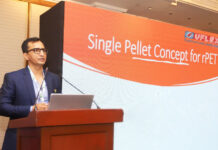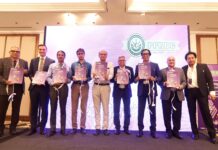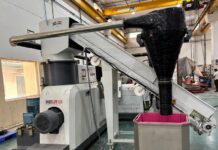this is one of the first CI press + EB curing installations in the world for hard core film-based flexible packaging. There are about 5 web flexo + EB curing presses already in operation but they are only doing paper and board laminates. Therefore
The press is a 1500 mm wide 10-colour Miraflex from Windmoller & Holscher that can run at 500 metres/minute and the EB curing station is being supplied by ESI. According to Uflex, this is one of the first CI press + EB curing installations in the world for hard core film-based flexible packaging. There are about 5 web flexo + EB curing presses already in operation but they are only doing paper and board laminates. Therefore, this is probably one of the first really hi-tech flexible packaging projects being pioneered by an Indian company. The press is being shipped out by the end of March 2009 and is due to commence commercial production by the middle of June this year.
The press will be used to print films and film laminates for niche applications for export markets that require a tailored coefficient of friction (COF) on the surface, high heat resistance, fade resistance, gloss, scuff resistance and suitability for food contact all of which can only be delivered by EB cured inks and coatings. EB curing is also the only radiation curing process that enables the press to be run at the rated speed and give instantaneous cure. The EB curing unit is located downstream of the CI print station as this process enables wet-on-wet printing without inter-station drying or curing that is required in conventional flexo printing using solvent-based, water-based or UV curable inks.
The Miraflex can run both conventional flexo plates and seamless flexo sleeves. Uflex will be processing the flexo plates/sleeves in-house and, for this, they are getting a state-of-the-art Cyrel FAST system from DuPont for digitally processing photopolymer plates without the use of organic solvents or aqueous washout. This process enables flexo plates to be processed and made ready in less than one hour and is very eco-friendly and safe as it totally does away with organic solvents and washing out and subsequent drying. The basic photopolymer plates/sleeves will also be imported from DuPont.
EB curable inks and coatings are not available in India and will be imported for the time being but Uflex intend to manufacture these in-house at their own ink-making plant later on. Although there are only a couple of global suppliers of good EB curable inks and coatings at the moment, their import will not be too expensive as the solids content of these formulations is 100 per cent.
One of the niche markets that Uflex are targetting is bulk bags (over 5 lbs) for fertilizers and potting soils — a large and high-value market, particularly in the USA. These packs are presently using LDPE bags that cannot be stacked very high because of the relatively low coefficient of friction (COF) on the outer surface. Even with additive modifications, there is a limit to stackability. The advantage of EB curable coatings is that they can not only deliver much higher COF values (as much as 0.7 to 0.8) but can tailor them very precisely. Large manufacturers of fertilizers and potting soils like Scott’s have a problem in that large retailers like Walmart charge them for display based on the floor space footprint occupied by them; unless they can stack their products adequately, the display costs become very high. The other problem they face is that these displays are usually on the outside of the main store where they are exposed to direct sunlight for several hours during the day causing all conventionally printed bags to fade. EB cured inks provide much better light stability and fade resistance They are also much more scuff-resistant and provide better protection to the surface print on the bags during handling and stacking. This technology will give Uflex a significant quality advantage over other manufacturers.
In the longer term, Uflex are also hoping to replace reverse printed 3-layer and 2-layer laminate specifications with 2-layer and monolayer specifications surface printed with EB cured inks respectively. The loss of barrier by eliminating the outside reverse printed layer (usually PET film) is not very significant and can be made up by using a suitable coextruded film structure. The improved print quality, gloss, and scuff resistance from EB cured surface printing inks should be comparable with reverse printing on oriented films. The removal of an expensive oriented film ply and the doing away with of an expensive dry lamination operation will also save a lot of cost.
Another limitation of the reverse printed specifications is that there is a problem with temperature resistance (oriented films shrink at high temperatures) when the sealing temperature has to be increased when higher rates of output are required on filling and sealing machines. In case BOPP film is used as the outer layer or as the monolayer, even if a suitable temperature resistant grade is used, the sealing temperature window is very narrow and this requires very close monitoring or specialised temperature controls during the filling and sealing operations. EB cured surface printed films should provide better temperature resistance to alleviate this problem.
The elimination of the reverse printed outer BOPET or BOPP ply and replacing them with surface printing should also make the laminates 100% recyclable — another significant advantage.
The market potential for reverse printed laminate specifications is really enormous and Uflex should be streets ahead of other laminate producers once they replace them successfully with laminates using a lower number of plies, as planned.
When I asked Mr. Pillai why they did not look at UV curing for surface printing and coatings, he told me that UV curing was never a serious option because of the many advantages provided by EB curing. (See technical article in the box.)
Briefly, the advantages of EB curing are as follows:
– The photo-initiators used in UV curable inks are not suitable for food contact and tend to migrate. Moreover, they leave a residual odour that is not acceptable.
– UV curing is not suitable for printing at high speeds (250 metres per minute or more).
– EB curing is the only process that will deliver the print quality and surface properties that they are looking for.
– EB curing is better for heat-sensitive substrates. No special cooling of the CI drum is required.
– UV curing is more energy intensive and more expensive on consumables (replacement of UV lamps and reflectors).
– UV curable inks and coatings require inter-station curing.
Uflex must be complimented for their innovative decision to achieve first-mover advantage with EB curing technology and for their astute planning of future developments regarding reverse printed laminates. These will certainly bring about quantum improvements and cost-efficiencies in laminate specifications and flexible packaging applications.
Editor’s note — Both Windmoller & Holscher and ESI will be exhibiting at Plastindia 2009.










